Some of us prefer to keep things simple or may not have ample space for an elaborate aquarium setup. If you’re one of them, worry not! Various fish species can live happily independently without fellow fishy roommates.
So let’s dive into the fascinating world of self-sufficient fish species as I share with you some top choices that don’t require buddies to flourish in your aquarium. After all, sometimes less really is more – even underwater!
- The Independent Betta
- The Solo Gourami
- The Lone Oscar
- The Self-Sufficient Pufferfish
- The Solitary Cichlid
- Frequently Asked Questions
- Can Different Species Of Fish That Prefer Living Alone Be Kept Together In The Same Tank, Or Will They Still Exhibit Territorial Behaviors?
- What Specific Tank Size And Setup Are Recommended For Each Of These Fish Species That Can Live On Their Own?
- Are There Any Special Dietary Requirements Or Feeding Habits For These Solitary Fish Species That Should Be Taken Into Consideration When Caring For Them?
- How Do The Life Spans Of These Fish Species Compare, And Are There Any Unique Health Concerns To Be Aware Of When Keeping Them As Pets?
- What Are Some Signs Of Stress Or Illness To Watch Out For In These Solitary Fish Species, And How Can These Issues Be Addressed To Ensure Their Well-Being?
- Conclusion
The Independent Betta
Ah, the beautiful and captivating Betta fish. Known for their vibrant colors and flowing fins, they are also quite popular among aquarists who desire a low-maintenance pet that can thrive independently.
What sets Bettas apart from many other fish is their unique personalities; some may be shy, while others may be bold and assertive. Regardless of their quirks, one thing remains consistent – these solitary creatures prefer to live alone in an ideal tank setup catered specifically to them.
Creating the perfect environment for your independent Betta begins with selecting the right size tank. A minimum of 5 gallons should suffice as it allows plenty of space for swimming, exploring, and establishing territory without feeling overcrowded or stressed.
Equipping the tank with a heater will ensure optimal water temperature (between 76-80°F), which is crucial since Bettas are tropical fish known to suffer from poor health if kept in colder conditions. Additionally, including hiding spots such as caves, plants, or decorations provides your aquatic companion ample opportunity to seek refuge when needed.
Now that you have created an idyllic haven for your solitary friend to flourish in peace, it’s essential not to disrupt this harmony by introducing unwanted neighbors. Remember that although Bettas might seem lonely at times, they’re content being solo swimmers due to their territorial nature.
With this knowledge in mind, it becomes clear why keeping only one Betta per tank eliminates potential aggression issues are often seen when multiple males or females reside together.
As we continue our journey through the world of loner fishes seeking companionship elsewhere in life’s vast oceanariums, let us explore another species: the solo gourami!
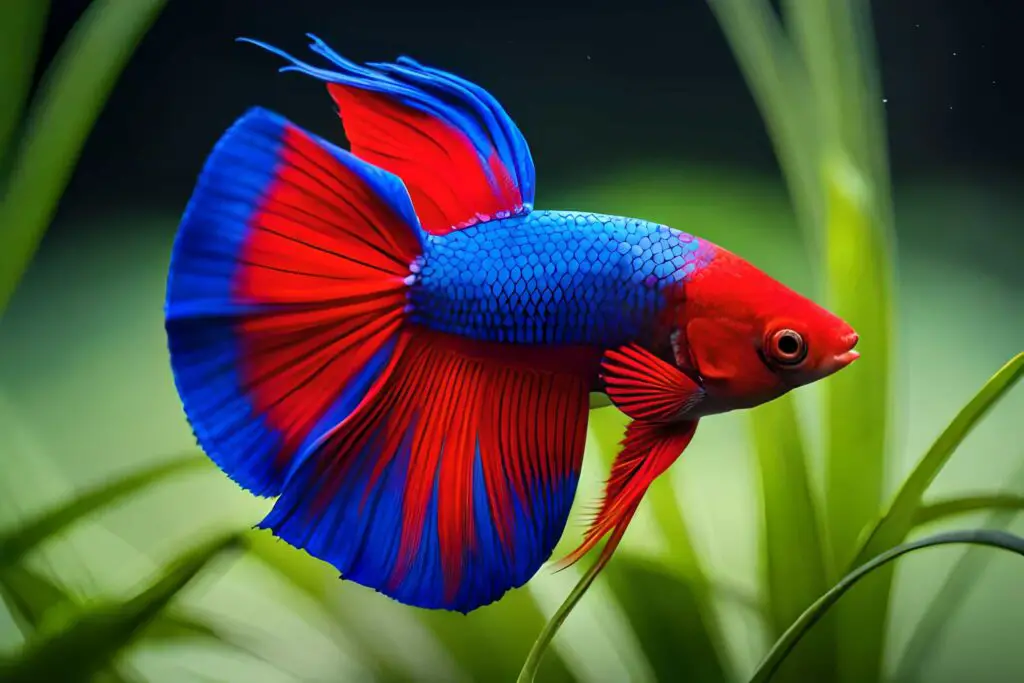
The Solo Gourami
Taking care of a Solo Gourami is relatively easy; they’re hardy fish that can tolerate a wide range of water parameters.
They usually live for 3-5 years, depending on their environment and the quality of care they receive.
I’ve had some of mine for more than 6 years, so it’s worth investing in a good aquarium setup for them.
Ensure you give them plenty of hiding spaces and regular water changes – they’ll thrive!
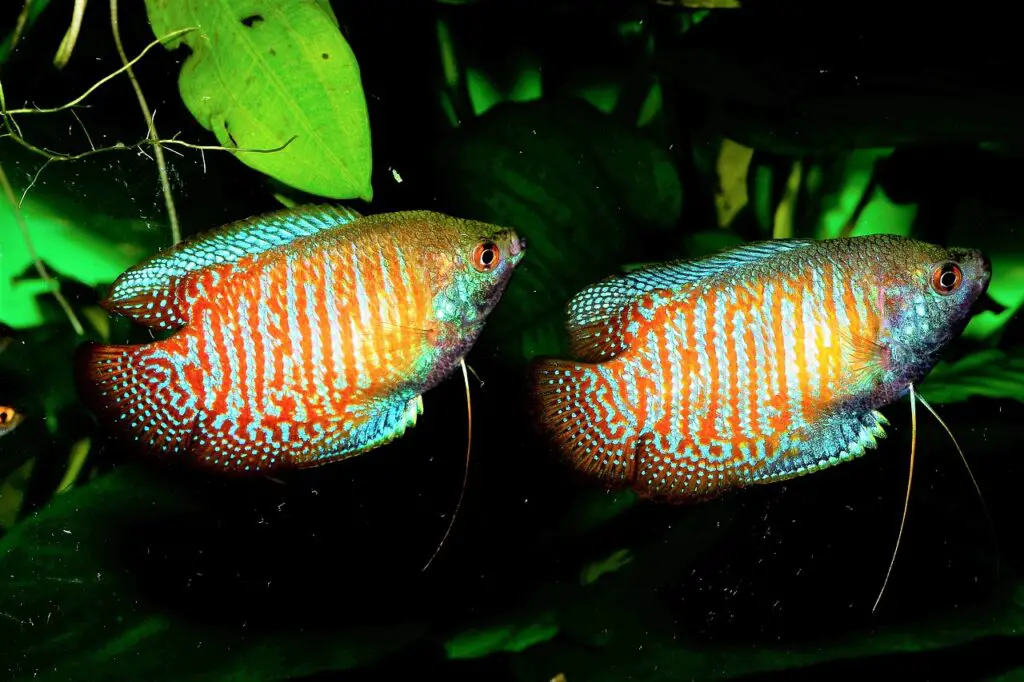
Care
Caring for a solo Gourami is a rewarding experience that allows you to focus all your attention on one spectacular fish. You’ll quickly realize their unique personalities and preferences make them an absolute joy to care for. As an experienced fishkeeper, I can tell you that providing the proper environment and meeting individual tank requirements are essential in ensuring your new aquatic friend thrives.
Solo fish maintenance doesn’t have to be complicated if you follow some basic guidelines. For starters, it’s crucial to maintain optimal water conditions by regularly checking temperature, pH levels, ammonia, nitrite, and nitrate concentrations. A suitable filtration system will work wonders to keep these parameters stable and create a healthy living space for your Gourami.
Providing adequate hiding spots within their habitat is essential since this species can become stressed if it feels exposed or vulnerable. Live plants such as Java Ferns make excellent additions for aesthetic purposes because they serve as natural filters and contribute towards improved water quality.
Feeding your Gourami appropriately plays a significant role in its overall well-being too. Offer a varied diet consisting of high-quality pellets or flakes and occasional treats like live or frozen foods (e.g., brine shrimp or bloodworms). This ensures they receive all the nutrients needed to stay happy and healthy while satisfying their instincts to hunt and scavenge.
Remember: taking exceptional care of our underwater friends is truly fulfilling when we see them flourish under our watchful eyes!
Lifespan
It’s truly amazing to watch our solo Gourami friends grow and flourish as they adapt and thrive within their carefully maintained environments. As an experienced fishkeeper, I know that understanding the factors affecting their lifespan is crucial for providing them a long and fulfilling life.
Generally, Gouramis have a lifespan of 4-6 years in captivity; however, some species can live even longer if given proper care.
One important aspect of ensuring your fish’s longevity is recognizing their unique adaptations and catering to these needs accordingly. For instance, Gouramis possess a labyrinth organ that allows them to breathe atmospheric air when necessary, so it’s essential to provide access to the water surface at all times.
Additionally, maintaining optimal water conditions by frequently monitoring parameters and performing regular partial water changes can significantly impact your fish’s overall health and extend its lifespan.
In conclusion, taking excellent care of our aquatic companions goes beyond just meeting their basic requirements; it also involves understanding the intricacies of their biology and behavior. By doing so, we contribute to their well-being and get immense satisfaction from watching them thrive under our dedicated care – because there’s nothing more rewarding than knowing you’ve played a vital role in nurturing another living being!
The Lone Oscar
Ah, the solitary king of the aquatic world – the Oscar. A fish that doesn’t require a royal entourage to thrive majestically in its underwater kingdom. This regal creature can live comfortably on its own without needing fellow finned friends.
As an experienced fishkeeper, I must say Oscars have personalities as grand as their reputation suggests. Each Oscar has a unique character which makes them fascinating and enjoyable companions.
However, with great personality comes great responsibility; one must ensure they provide adequate tank necessities for these independent creatures to flourish gracefully. Oscars prefer spacious tanks (at least 55 gallons) to accommodate their potential size of up to 12 inches long. Additionally, it’s essential to maintain pristine water quality since poor conditions could lead to health issues or dull their vibrant colors.
Now, let us not forget about the self-sufficient pufferfish…
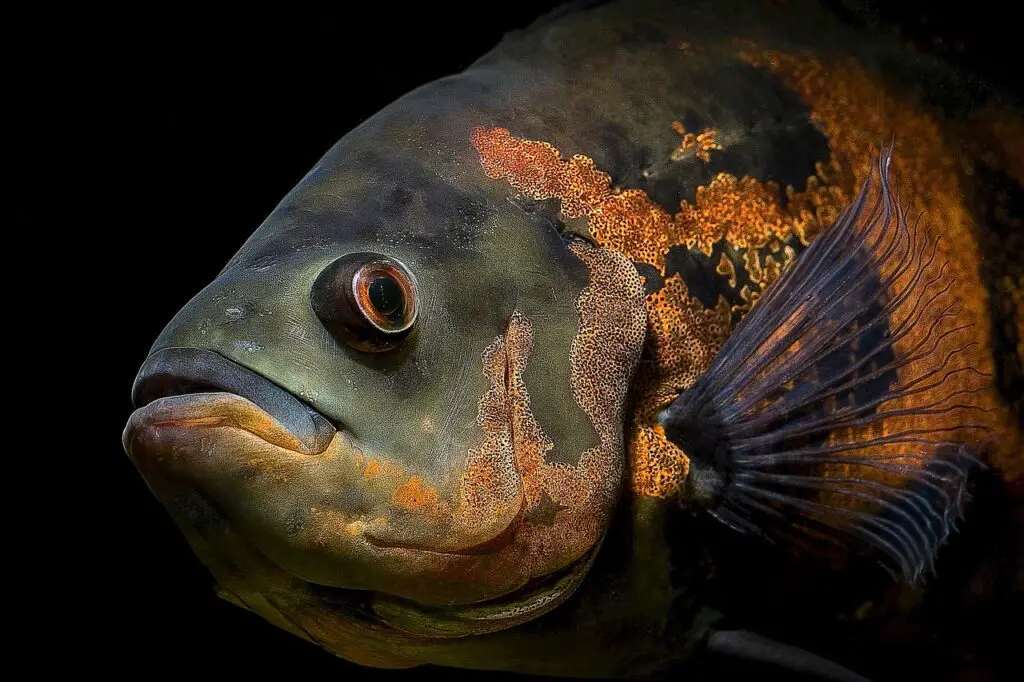
The Self-Sufficient Pufferfish
Now that we’ve delved into the fascinating world of Oscars let’s explore another fish that can thrive in solitude: the self-sufficient pufferfish. These captivating creatures make a statement with their distinct appearance and unique adaptations, allowing them to live happily independently. As you continue your journey as a dedicated fish keeper, it is essential to understand how these remarkable species have evolved to survive without constant companionship.
Creating an ideal environment for your pufferfish starts with understanding its natural habitat. Pufferfish are typically found in tropical marine environments such as coral reefs or estuaries, where they can feed on crustaceans and small invertebrates. In captivity, replicating this setting by providing ample hiding spaces like rock formations or driftwood helps create a sense of safety for your solitary swimmer while offering enrichment opportunities.
A well-established aquarium with stable water parameters will ensure your puffer’s health and happiness and satisfy your inner desire to provide exemplary care. From inflating themselves when threatened to display intricate patterns on their skin, pufferfish exhibit some truly awe-inspiring behaviors which captivate both experienced aquarists and casual observers alike.
Their independent nature makes them an excellent choice for those who want a singular focal point in their aquatic display while fulfilling one’s innate longing to nurture another living being. So indulge yourself in the satisfaction of caring for these exceptional individuals – after all, every creature deserves someone who understands its needs and appreciates its uniqueness.
Next up, get ready to dive into the realm of the equally intriguing solitary cichlid!
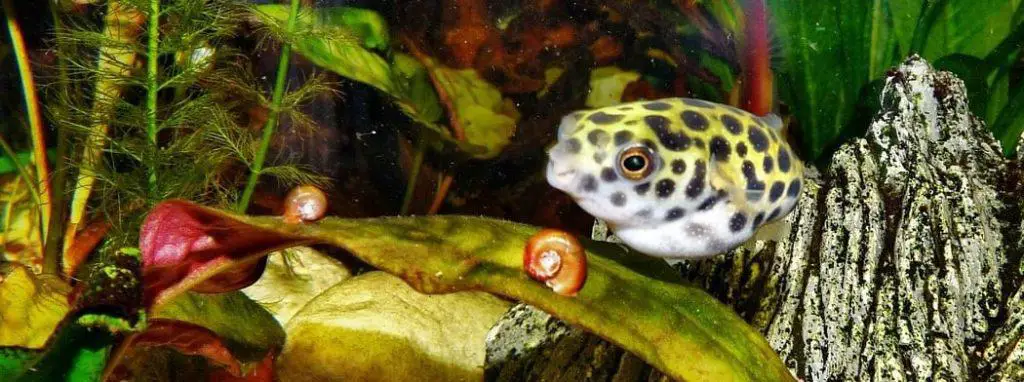
The Solitary Cichlid
Like a lone wolf in the aquatic world, the solitary Cichlid thrives independently and can be an ideal pet for those who wish to focus on one fish at a time.
These fascinating creatures captivate the hearts of many experienced fish keepers with their unique personalities and engaging behaviors.
Cichlid personalities are as diverse as they come; some are aggressive, while others lean towards being more peaceful. Knowing your specific Cichlid’s temperament is essential before creating its habitat.
Ideal tanks for these individualistic swimmers include ample hiding spots such as caves or rocky structures, which provide them with a sense of security and comfort. Additionally, live plants add beauty to the tank and offer extra shelter for your beloved fishy friend, allowing them to feel genuinely at home in their underwater kingdom.
As you venture into the mesmerizing world of solitary Cichlids, remember that catering to their needs will result in a happy and healthy fish that brings joy to themselves and their doting caregivers.
So take pride in providing exceptional care tailored specifically to your unique aquatic companion, knowing that you’re directly contributing to their well-being and happiness – after all, there’s no greater reward than seeing your scaly sidekick thrive under your attentive support!
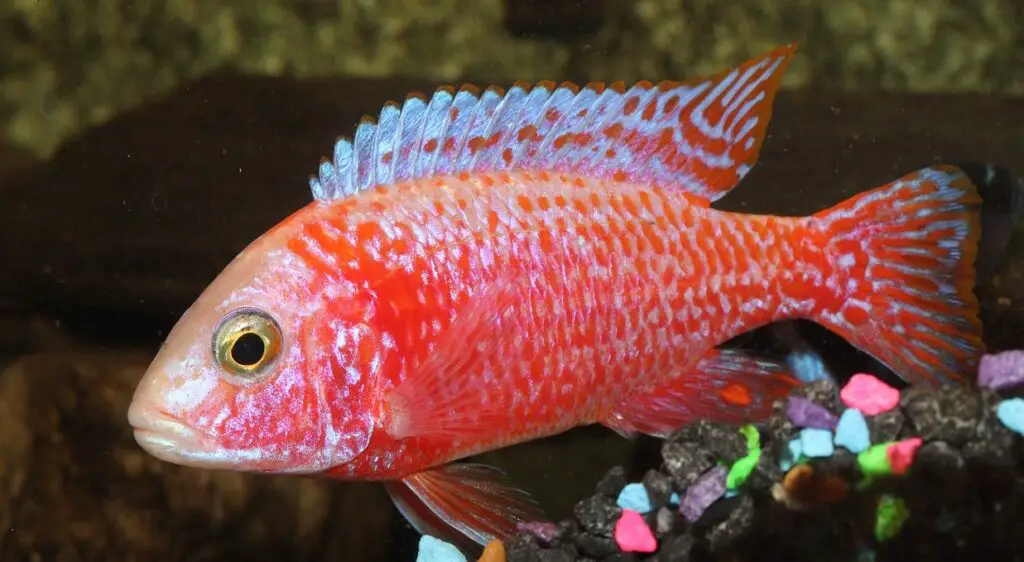
Frequently Asked Questions
Can Different Species Of Fish That Prefer Living Alone Be Kept Together In The Same Tank, Or Will They Still Exhibit Territorial Behaviors?
As an experienced fish keeper, I can tell you that tankmate compatibility is still essential to maintaining a harmonious aquatic environment even when dealing with solitary fish species.
Although certain species may prefer living alone, combining them in the same tank doesn’t guarantee harmony among these reclusive underwater neighbors.
Solitary fish behavior often includes territorial tendencies that could lead to conflicts and stress for all inhabitants.
So, suppose you’re looking to serve your finned friends’ best interests. In that case, it’s crucial to research each species’ preferences and behaviors before introducing them in the same aquarium – ensuring peaceful coexistence and promoting their overall well-being.
What Specific Tank Size And Setup Are Recommended For Each Of These Fish Species That Can Live On Their Own?
Did you know that providing the right tank size and setup can increase your fish’s lifespan by up to 50%?
For those solitary fish species we love, like bettas, African dwarf frogs, cichlids, or even aquatic snails – creating a comfortable home is essential. Ideal tank decorations should cater to their needs: think caves for hiding spots in cichlid tanks or live plants for bettas.
When designing DIY fish tank setups, consider the unique requirements of each species; substrate preferences, water temperature ranges, and compatible flora are all crucial aspects.
As an experienced fish keeper, I’ve learned that fostering a healthy environment benefits our finned friends and serves as a rewarding experience for ourselves – there’s nothing quite like watching them thrive in a space tailored just for them!
Are There Any Special Dietary Requirements Or Feeding Habits For These Solitary Fish Species That Should Be Taken Into Consideration When Caring For Them?
Caring for our finned friends with unique fish habitats and solitary fish breeding habits requires special attention to their dietary needs.
As an experienced fish keeper, I can tell you that it’s crucial to research each species’ specific diet preferences and feeding frequency to ensure they thrive in your aquarium.
Many of these solo swimmers have diverse food choices, ranging from live or frozen foods like brine shrimp and bloodworms to high-quality pellets designed for particular types of fish.
Keep in mind, overfeeding can lead to poor water quality and health issues; therefore, serving the right portion size is essential for maintaining a happy and healthy environment for your aquatic buddies.
By catering to their individual nutritional requirements, you will foster a deeper connection with them and contribute towards creating a harmonious underwater world where they can flourish on their own terms.
How Do The Life Spans Of These Fish Species Compare, And Are There Any Unique Health Concerns To Be Aware Of When Keeping Them As Pets?
There’s quite a range in lifespan comparison and unique health concerns of solitary fish species.
For example, bettas typically live around 3-5 years with proper care, while goldfish can live for over a decade if their environment is well-maintained.
On the other hand, guppies have shorter lifespans of about 1-2 years but are hardy and easy to look after.
Each species has specific needs – keeping your water clean and monitoring ammonia levels is crucial in maintaining their health.
Knowing how best to serve these aquatic companions means being aware of potential issues such as fin rot or swim bladder problems that could arise due to poor water quality or improper diet.
By staying informed on each species’ requirements and showing attentive care, you’ll be able to provide them with the optimal environment they deserve!
What Are Some Signs Of Stress Or Illness To Watch Out For In These Solitary Fish Species, And How Can These Issues Be Addressed To Ensure Their Well-Being?
As a seasoned fishkeeper, it’s essential to be aware of solitary fish behaviors and recognize the signs of stress or illness. Stress prevention is crucial for their well-being!
Keep an eye out for changes in coloration, erratic swimming patterns, loss of appetite, rapid breathing, and white spots on their body – these could indicate that your finned buddy is struggling.
To ensure they remain happy and healthy, maintain optimal water quality by performing regular water changes, provide them with a suitable habitat, including hiding spaces and plants, feed them a balanced diet suited to their species, and avoid overcrowding.
Remember, as empathetic caretakers, our goal is to make sure our aquatic companions thrive in their environment while we enjoy the pleasure of serving others through nurturing life.
Conclusion
So, what’s the verdict on keeping these solitary fish species together? Will they coexist peacefully or bring chaos to your carefully curated tank? The truth is, it all depends on their temperaments and the specific conditions you provide for them.
Only time will tell if these independent swimmers can learn to share their space.
As an experienced fishkeeper, observing and understanding each unique creature is essential to maintaining a harmonious aquatic environment. Remember, a happy fish makes for a happy hobbyist!
So keep a close eye on your finned friends and be prepared to make adjustments as necessary to ensure their well-being.
Good luck, and enjoy the fascinating world of solitary fish care!

